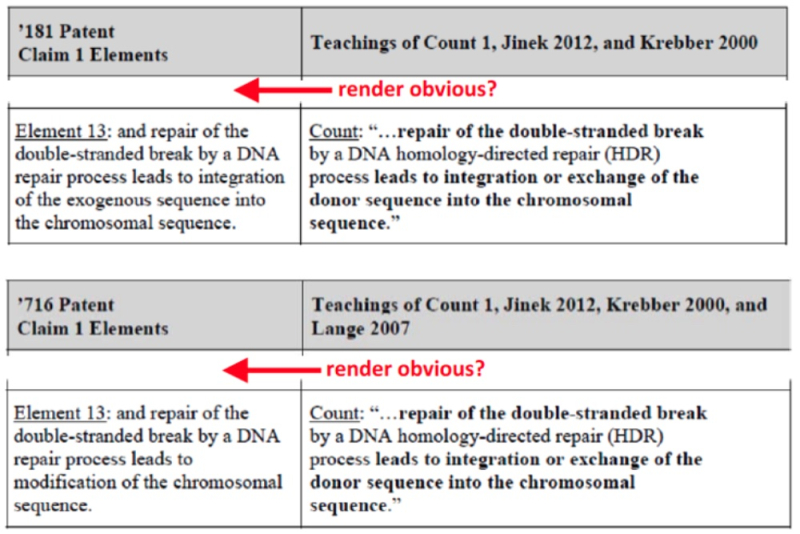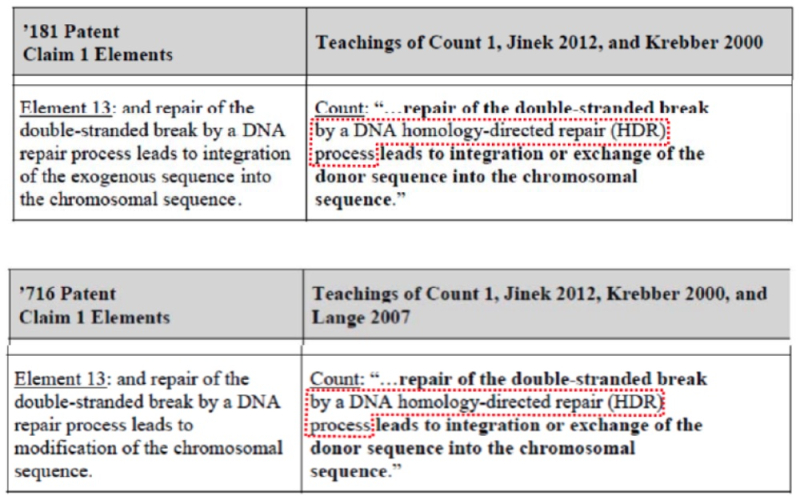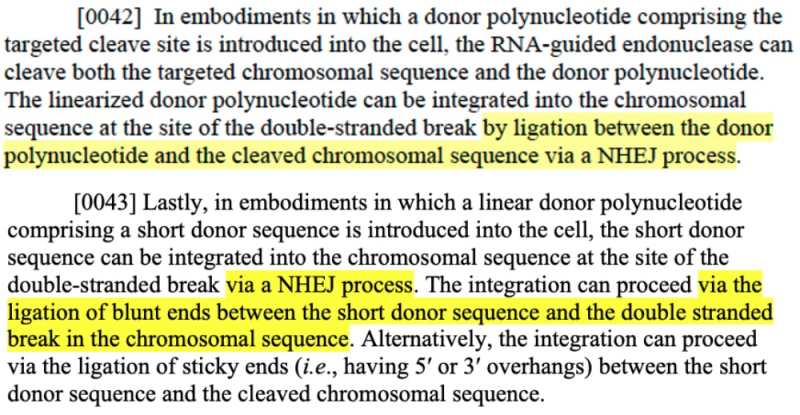CVC identified what it characterizes as only "nominal differences" between the Count and the claims to be designated in these two patents as "the recitation of the well-established Cas9 protein (from S. pyogenes), a well-known nuclear localization signal (a C-terminal SV40 NLS), and the natural and previously disclosed location for the DNA-targeting region (at the 5' end of the guide RNA)." None of these differences render these claims patentably distinct from the Count, as evidenced CVC argued by "highly similar claims already being involved in this proceeding as part of Sigma's U.S. Application No. 15/456,204." These claims satisfy the test set forth under 37 C.F.R. § 41.207(b)(2) and Standing Order ¶ 208.3.1 that claims correspond to the Count where "the subject matter of the count, if treated as prior art, would have anticipated or rendered obvious the subject matter of [each] claim." This test is satisfied if additional references are relied upon to make out a prima facie case of obviousness CVC argued, citing Desjardins v Wax, Interference No. 105,915, Paper 125, 17-20 (P.T.A.B. Jan. 21, 2014). The basis for CVC's argument that the distinctions set forth above do not render these clams patentably distinct was that these distinctions are found in the cited prior art or were otherwise "well known," the brief setting forth reasons for the Board to reach this conclusion. Finally, CVC argued there are no objective indicia (or secondary considerations) that would provide the missing distinctions.
Sigma-Aldrich's Opposition contends that CVC failed to apply the proper "two-way test" for determining whether a claim corresponds to an interference Court. Sigma-Aldrich cites a decision from the PTAB's predecessor, the Board of Patent Appeals and Interferences, for the definition of "the same patentable invention" as requiring a "two-way obviousness test," citing Winter v. Fujita, 1999 Pat. App. LEXIS 7, *49-50, 53 U.S.P.Q.2d (BNA) 1234, 1248 (BPAI Nov. 16, 1999). Noting that the rules for patent interferences were changed in 2004, Sigma-Aldrich sets forth the current rules as follows:
• A party may suggest the addition of a patent or application to the interference or the declaration of an additional interference. The suggestion should make the showings required under §41.202(a) of this part. 37 C.F.R. §41.203(d) [emphasis added].
• For each count, provide a claim chart comparing at least one claim of each party corresponding to the count and show why the claims interfere within the meaning of §41.203(a). 37 C.F.R. §41.202(a) [emphasis added].
• Interfering subject matter. An interference exists if the subject matter of a claim of one party would, if prior art, have anticipated or rendered obvious the subject matter of a claim of the opposing party and vice versa. 37 C.F.R. §41.203(a) [second emphasis added].
And illustrates application of these rules in Ledenev v. Adest, 2020 Pat. App. LEXIS 6912, *35-36, Decision on Motions, at 31, 35 (PTAB Mar. 25, 2020) (JTM) (In moving to add patents to an interference, "[t]he standard to be applied is whether the claim is patentably distinct from the Count . . . . [T]he burden placed upon movant [is] to compare the claims to the count in the required two way analysis."). Sigma-Aldrich also notes (in a footnote) in this regard that "[t]he authority cited by CVC [37 C.F.R. § 41.207(b)(2) ("Claim correspondence"); Standing Order 208.3.1 ("Claim correspondence")] is directed to the analysis of whether a claim of an already involved patent or application corresponds to the interference count." Such a one-way test would be appropriate, Sigma-Aldrich argues, only for showing claim correspondence to an interference Count for claims of an already-involved patent or application. Applying the two-way obviousness test, Sigma-Aldrich's brief illustrates CVC's purported error with regard to "Element 13" for claims in both Sigma-Aldrich's '181 and '716 patents:

Sigma-Aldrich further argues in this regard that what CVC set forth in its Motion No. 4 is whether the narrower interference Count would render obvious the '181 or '716 patent claims. What CVC failed to do was the converse assessment, whether "the broader claim render[s] obvious the narrower Count" (emphasis in brief).
In addition, Sigma-Aldrich argues that CVC failed to assert whether the "homology-dependent repair (HDR)" aspects of the Count would have been non-obvious when considered in view of Element 13 of the '181 and '716 patent claims:

(Sigma-Aldrich noting that, unlike other portions of the Count and prior art, CVC did not emphasize language relating to this aspect in its analysis.) Sigma-Aldrich also asserts that "none of the Sigma Patents claims recite a homology-directed repair (HDR) process," being directed (more broadly) to "repair of the double-stranded break by a DNA repair process" and, in its P1 provisional (Application No/ 61/734,256, filed December 6, 2012) disclosing "non-HDR processes" involved in DNA repair (emphasis in brief). These processes included non-homologous end joining (NHEJ), illustrated with these examples:

Sigma-Aldrich also criticizes CVC's description of the contents of the Jinek (2012) reference, which Sigma-Aldrich contends contain "no teachings about cleaving eukaryotic DNA."
Sigma-Aldrich also argues that CVC has been "on notice" from both its positions in its List of Proposed Motions and the Board regarding the patentable distinctions between what it terms "cleavage" embodiments of eukaryotic CRISPR and "cleavage + integration" embodiments. Similarly, Sigma-Aldrich contends, the Board in its "Order Authorizing Motions" drew similar distinctions with regard to its basis for authorizing Sigma-Aldrich to file its Motion No. 1 to Substitute Proposed Count 2. And, Sigma-Aldrich argues, both CVC Claim 164 and Sigma Claim 31 (comprising separate portions of the McKelvey Count in the Interference as declared) "expressly recite [a] limitation directed to cleavage plus integration via HDR." In view of such notice, Sigma-Aldrich argues that "CVC has no justifiable excuse for failing to address that fundamental issue in its CVC Motion 4."
Sigma-Aldrich also contends that CVC's Motion No. 4 would become moot should the Board grant its Preliminary Motion No. 1 to change the Count. This is because, inter alia, CVC did not address Sigma-Aldrich's Proposed Count 2 in its Motion No. 4 nor did CVC file a responsive motion to add Sigma-Aldrich's U.S. Patent Nos. 10,731,181 and 10,745,716.
The brief concludes with citations to the interference rules and the regard showing that the Board can in its discretion under the circumstances in this interference deny CVC's Motion No. 4, which Sigma-Aldrich asks them to do.
* CVC captioned this as a Miscellaneous Motion.